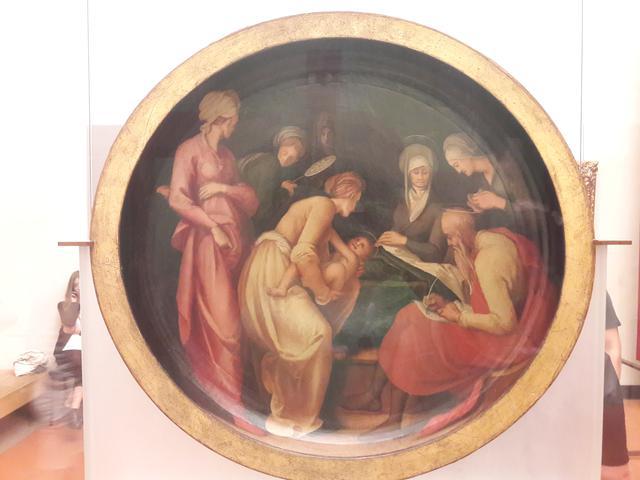The Nativity of Saint John the Baptist

The Nativity of Saint John the Baptist is an oil painting on panel by Pontormo, dating from 1526. It is a nativity table.
Judging by the crest on the back, the work had to be done to celebrate the birth of Aldighieri della Casa (January 15, 1527), firstborn of Girolamo della Casa and Lisabetta Tornaquinci, married in 1521. The table was a tray used by Florentine families. more affluent, with which a first meal, generally a broth, was served immediately after birth; For this reason, there were often well-desired allegorical themes or sacred episodes related to the nativity. In the 16th century, however, it was an obsolete object, linked to the last century, which was probably commissioned by family tradition.
The work has been in Florentine galleries since at least 1704. Philippe Costamagna discarded his autograph, although his hypothesis was not widely followed in criticism.
A copy exists in the Fogg Museum of Art in Cambridge.
The work shows the nativity scene of Saint John organized with a certain compositional originality. Saint Elizabeth's bed is arranged horizontally and the woman looks at the seat as she watches her husband Zaccaria, who writes the name of the unborn child, breaking the punishment that forced him to remain silent due to the disbelief reserved for the angel who gave him had warned of the birth of a son. A maid holds the child in her arms in the center, placing it diagonally along a line of force leading to the mother's face. Other women crowd around, one leans to the right to read the name on the sheet, Elizabeth waves and one watches from a dark curtain in the background, while a fourth towers at the left edge.
As in the frescoes of the Certosa di Firenze cloister, the Nativity of the Baptist shows clear links with Nordic and Durerian figurative culture in particular, thanks to the elongated types of bodies, physiognomies and leaves of clothing. The spatial depth appears diminished, as in other works by the artist. The wealth of poses and gazes that do not meet directs the viewer's eye from one extreme to the other, with a dynamism and refinement typical of refined mannerism.
On the back, the two family arms of the spouses are united in a single shield on a dark background, with two anthropomorphic grotesques of notable refinement. The faux porphyry frame is painted with great skill.
© Tourblink